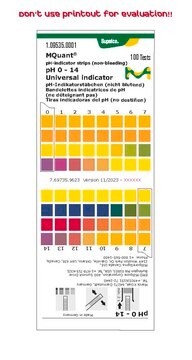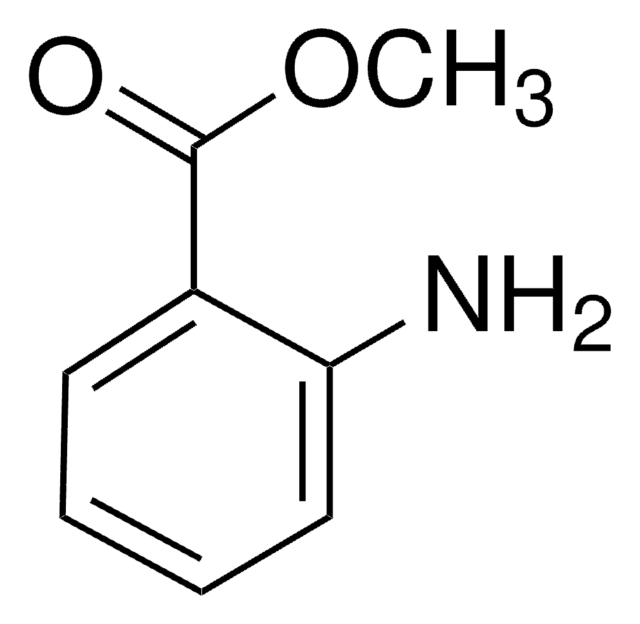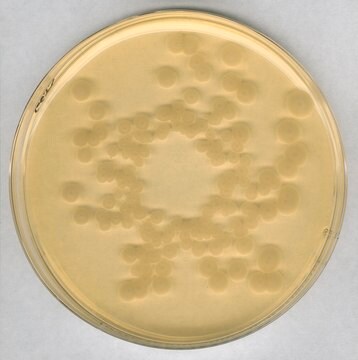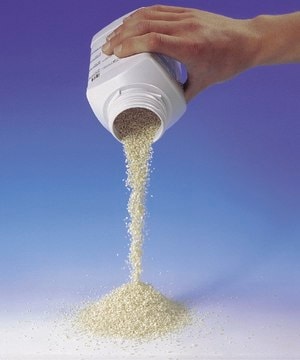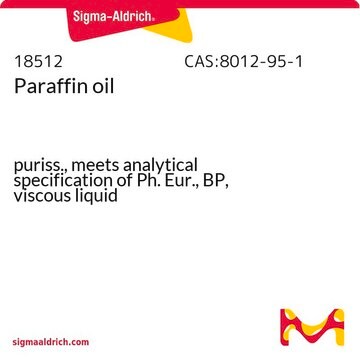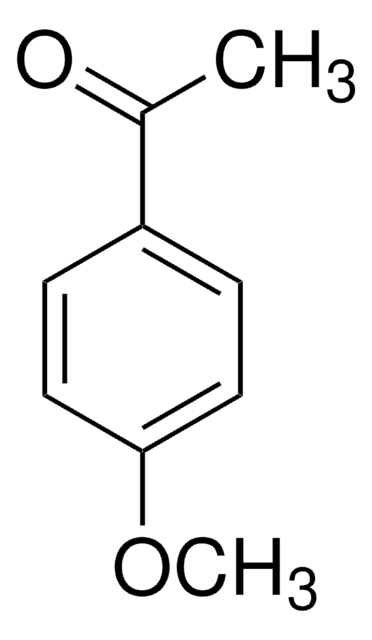W269905
6-Methylcoumarin
≥99%, FCC, FG
동의어(들):
6-methylchromen-2-one, Cocodescol, Pralina, Toncair, Toncarine
로그인조직 및 계약 가격 보기
모든 사진(1)
About This Item
실험식(Hill 표기법):
C10H8O2
CAS Number:
Molecular Weight:
160.17
FEMA Number:
2699
EC Number:
유럽평의회 번호:
579
MDL number:
UNSPSC 코드:
12164502
PubChem Substance ID:
플래비스(Flavis) 번호:
13.012
NACRES:
NA.21
추천 제품
생물학적 소스
synthetic
Quality Level
Grade
FG
Halal
Kosher
Agency
meets purity specifications of JECFA
규정 준수
EU Regulation 1334/2008 & 178/2002
FCC
분석
≥99%
bp
303 °C/725 mmHg (lit.)
mp
73-76 °C (lit.)
응용 분야
flavors and fragrances
문건
see Safety & Documentation for available documents
식품 알레르기항원
no known allergens
감각 수용성의
coconut; creamy; sage; vanilla
SMILES string
Cc1ccc2OC(=O)C=Cc2c1
InChI
1S/C10H8O2/c1-7-2-4-9-8(6-7)3-5-10(11)12-9/h2-6H,1H3
InChI key
FXFYOPQLGGEACP-UHFFFAOYSA-N
유사한 제품을 찾으십니까? 방문 제품 비교 안내
애플리케이션
- Development of Sustainable Insecticide Candidates for Protecting Pollinators: Insight into the Bioactivities, Selective Mechanism of Action and QSAR of Natural Coumarin Derivatives against Aphids.: This study explores the potential of 6-Methylcoumarin and other natural coumarin derivatives as sustainable insecticides, highlighting their bioactivities and selective mechanism of action. The research aims to protect pollinators while targeting aphids, providing a promising alternative to conventional pesticides (Zhou et al., 2023).
- Conductive Vial Electromembrane Extraction of Opioids from Oral Fluid.: This research presents a novel method using conductive vial electromembrane extraction for isolating opioids from oral fluid. While the primary focus is on opioids, the study utilizes 6-Methylcoumarin as a key component in the extraction process, showcasing its versatility in analytical chemistry applications (Skaalvik et al., 2023).
- 6-Methylcoumarin Promotes Melanogenesis through the PKA/CREB, MAPK, AKT/PI3K, and GSK3β/β-Catenin Signaling Pathways.: This article investigates the role of 6-Methylcoumarin in promoting melanogenesis, detailing the molecular pathways involved. The findings suggest potential applications in dermatology and cosmetic science, particularly in skin pigmentation treatments (Kim et al., 2023).
- Recursively Positive and Negative Chemotaxis Coupling with Reaction Kinetics in Self-Organized Inanimate Motion.: This research delves into the chemotactic behavior of inanimate particles, using 6-Methylcoumarin in the reaction kinetics studies. The study contributes to the understanding of self-organizing systems, with implications for material science and biophysics (Matsuo et al., 2023).
생화학적/생리학적 작용
Taste at 5 ppm
신호어
Danger
유해 및 위험 성명서
Hazard Classifications
Acute Tox. 4 Oral - Resp. Sens. 1 - Skin Sens. 1
Storage Class Code
11 - Combustible Solids
WGK
WGK 3
Flash Point (°F)
Not applicable
Flash Point (°C)
Not applicable
개인 보호 장비
dust mask type N95 (US), Eyeshields, Faceshields, Gloves
이미 열람한 고객
Masatoshi Hoya et al.
Toxicology in vitro : an international journal published in association with BIBRA, 23(5), 911-918 (2009-04-11)
In this study, with the aim of developing a cell-based in vitro photosensitization assay, we examined whether changes of CD86 and CD54 expression on cells of a human monocytic cell line, THP-1, could be used to assess the photosensitizing potential
Feiying Zhang et al.
Spectrochimica acta. Part A, Molecular and biomolecular spectroscopy, 71(2), 710-713 (2008-03-25)
The infrared absorption spectra of the carbonyl stretching vibrations of 6-methylcoumarin (6MC) have been investigated in CCl4/ROH mixtures (CCl4/C2H5OH, CCl4/n-C3H7OH, CCl4/i-C3H7OH, and CCl4/t-C5H11OH). Two types of carbonyl stretching vibration bands for 6MC are found with the change of the mole
F X Bernard et al.
Cell biology and toxicology, 16(6), 391-400 (2001-03-20)
The reconstituted human epidermis model SkinEthic was used to evaluate the phototoxicity of topically applied chemicals. For comparison with published data, we first tested a library of 13 nonphototoxic (NPT) and phototoxic (PT) compounds, applied onto SkinEthic reconstituted human epidermal
Anuradha Ramoji et al.
Spectrochimica acta. Part A, Molecular and biomolecular spectroscopy, 77(5), 1039-1047 (2010-09-22)
Infrared absorption and Raman spectra (3500-50 cm(-1)) of 3-acetyl-6-bromocoumarin and 3-acetyl-6-methylcoumarin have been measured and interpreted, aided by electronic structure calculations at RHF and B3LYP using 6-31(d, p) basis set. It has been determined that the rotation of the acetyl
W P Jordan
Contact dermatitis, 8(2), 109-116 (1982-03-01)
This report describes modifications in the techniques used for both the induction and elicitation of photoallergic contact dermatitis (PACD) in the guinea pig. These changes have improved the reliability of this animal as the model of choice for screening chemicals
자사의 과학자팀은 생명 과학, 재료 과학, 화학 합성, 크로마토그래피, 분석 및 기타 많은 영역을 포함한 모든 과학 분야에 경험이 있습니다..
고객지원팀으로 연락바랍니다.
